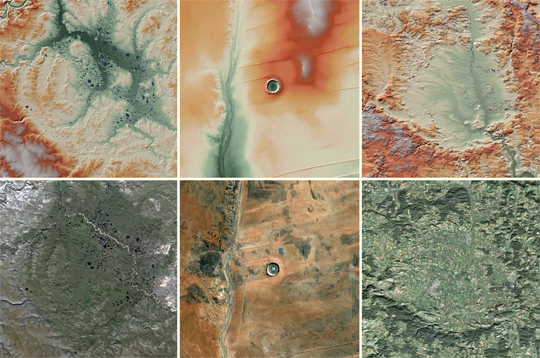Where the Earth Shook and Rumbled
Freiburg, Mar 09, 2021
The geologist Prof. Dr. Thomas Kenkmann from the Institute of Earth and Environmental Studies at the University of Freiburg, the mineralogist Prof. Dr. Wolf Uwe Reimold from the University of Brasilia in Brazil, and Dr. Manfred Gottwald from the German Aerospace Center (DLR) spent three years collecting data on and writing descriptions for every known meteor crater on Earth for their new atlas. Thomas Kenkmann is excited about this mammoth project titled Terrestrial Impact Structures, volumes 1 and 2. Claudia Füßler talked to him about the project.

The atlas presents all 208 known craters on Earth. Source: Manfred Gottwald, Thomas Kenkmann, and Wolf Uwe Reimold. Terrestrial Impact Structures, The TanDEM-X Atlas. Munich: Verlag Dr. Friedrich Pfeil, 2020.
Prof. Dr. Kenkmann, there are already books that list all of the craters on Earth. What is different about your atlas?
Thomas Kenkmann: You’re right, there are already two books out there about craters, but they’re not complete because they aren’t up to date. The initiative for this project was the DLR’s TanDEM-X mission, which was able to measure the Earth’s surface with radar satellites. This resulted in the first complete terrain model of the Earth with a height accuracy of up to one meter. This was the ideal opportunity to collect the data of all known craters. As experts who have been researching craters for more than two decades, the three of us pooled our skills and experience into this project. The result is a unique book that sets new standards in terms of quality and scope.
How many craters have been found so far?
At the moment 208, although there are a few that still need to be verified whether they’re actually craters or not, and for that we need evidence.
What kind of evidence?
There have to be special rocks and minerals there that are shocked. By this, I mean when a meteorite hits the surface, the resulting temperature and pressure is so strong for a short period of time that this creates permanent changes in the rock. We have to verify that every crater has this kind of changed rock.
How do you find new craters? Do you scan for them on Google Earth?
A lot of people do that, yes. For example, you can get geosciences students or lay people involved who can look for unusual structures in the landscape. Unfortunately, the number of hits is very low with this method. In their original shape, small craters look like a bowl, while larger craters often have a different shape with a mountain in the center, like on the Moon. However, only very few craters on Earth are so well preserved that they can be detected easily from above.
So what is your approach?
We use various high-definition remote sensing data and digital height models. What’s more common, however, is that a geological excavation is done in a particular area and the scientists find something that they can’t explain. That’s when they call the crater researchers – although we’re a relatively new field of research, because we’ve only been around for about 60 years.
And can you determine on-site if it’s a crater?
Yes. But it’s not as simple as it may sound. It takes a lot of effort and detective work. For example, sometimes craters are buried beneath more recent layers. In this case, we have to drill deep to find the layer of rock. Geophysical anomalies in the bedrock also help to find a crater and determine its size. The Chicxulub crater on the Yucatan peninsula in Mexico was also found by putting the pieces of the puzzle together. It’s 180 kilometers in diameter, which makes it the third-largest crater that we know of.

Thomas Kenkmann has studied, researched, and geologically mapped about 40 craters on site. Photo: Jürgen Gocke
How was it discovered?
We knew that a massive cosmic event happened between the Cretaceous and Tertiary period, roughly 66 million years ago, that led to the extinction of the dinosaurs, among other things. In the boundary layer I was talking about before, researchers found a large concentration of a very rare precious metal called iridium, which is concentrated in meteors. This layer became thicker in the direction of North America and Mexico and led to the Chicxulub crater.
Do you have a favorite crater?
That’s a tough question. I’ve studied, researched in detail, and geologically mapped about 40 craters on site. Some of those craters created spectacular landscapes. Many craters are in areas that are very rough and difficult to reach, in places where humans have had little impact on nature. What especially fascinated me is the Upheaval Dome crater in Utah in the US, for example. The crater there has lost its original form because it has eroded so much. But its extremely steep slopes are perfect for a three-dimensional view of the bottom of the crater. I also have a soft spot for Australian craters because of the landscape. We went on many expeditions there and spent weeks in no man’s land, all by ourselves. It was a great adventure.
Two hundred and eight craters have been found on Earth so far. Does the crater research community have an idea about how many more could be found?
That’s a question I’ve been asking myself for a long time. When you look at the surface of other planets like Mars or the Moon, it’s clear that impacts are part of fundamental processes. But at the same time, craters are also subject to the dynamic process of erosion. So, we’ve taken the probability of impacts and combined this with the rate of erosion, and we calculated that there should be about 250 to 300 more craters on Earth that we haven’t found yet. These are mainly smaller craters that are less than six kilometers in diameter.
Could craters also be on the ocean floor?
In principle, yes. Two-thirds of the Earth is covered in water, so about two-thirds of all impacts also must have been in the oceans. But many of the impacts don’t reach the ocean floor. Instead, they create a water crater that results in tsunamis. Only larger asteroids reach the bottom of the ocean, but because the oceanic crust is roughly 60 million years old, it’s younger than the continental rock. This means that any possible craters that are older than that have long been destroyed through subduction, or the sinking of the oceanic plates into the Earth’s crust.
How often does a meteorite hit the Earth?
That depends a lot on size. A meteorite that leaves a crater the size of Chicxulub in Mexico hits the Earth roughly every 100 million years. A crater that’s about 25 kilometers in diameter, like the Nördlinger Ries in southern Germany, happens every one million years. Something like the Barringer crater in Arizona in the US, which is roughly 1.2 kilometers in diameter, statistically occurs every 1,000 years.
So it’s a rare event.
Definitely. In geology, we think in terms of long stretches of time. Earthquakes and volcano eruptions are more frequent. That having been said, a major impact can have a much more catastrophic effect.

